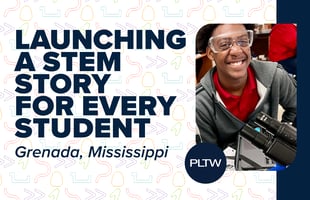What are the chances that an aerospace engineer knows she’s excited about the field without an early introduction to the science of flight? Or that a biomedical researcher embarks on his career in biophysics without having learned at a young age about the fundamentals of motion? Slim, data suggests. Studies show that students decide as early as second grade whether they like – and think they are good at – math. In other words, by age 7 or 8, they begin telling themselves that they are “good” or “bad” at solving problems. Some students have already begun to narrow their options, possibly self-selecting out of opportunities.
At Project Lead The Way, our mission is to prepare students for the global economy. As we reviewed data on the importance of introducing students at a young age to science, technology, engineering, and math (STEM), we were compelled to take action. We have provided in-school STEM curriculum for millions of middle and high school students since 1997. Recently, we made the decision to bring our activity-, project-, and problem-based curriculum and professional development to elementary school: In fall 2014, we will launch an elementary program, connecting STEM learning for students from kindergarten to career.
This is what we know: Students are more likely to see themselves as capable and confident discoverers when they take intellectual risks early and often. As Glory Oljace, author of STEM is Elementary: How Elementary Science, Technology, Engineering and Mathematics Prepares Students to Beat the Gaps!, states, students “cannot be expected to think critically for the first time in STEM subjects in middle school or beyond if they have not had the opportunity throughout elementary grades to experience STEM.” Introducing students to STEM when they are young helps them see new perspectives and discover new talents. Ultimately, it gives students the opportunity to begin a pathway toward many great career options.
Early exposure to STEM programs matters for all students, but it is especially important for minority and female students. Data shows a large interest and achievement gap in STEM; African Americans, Hispanics, Native Americans, and women are seriously underrepresented in many STEM fields. With the U.S. aiming to regain its global leadership in talent-driven innovation, we must open doors for everyone.
The case to engage all students in STEM when they are young is strong. Yet data also shows how challenging it may be in practice to implement. It is common for elementary teachers to shy away from teaching STEM subjects , and their apprehension is easy to understand: The Report to the President’s Council of Advisors on Science and Technology finds that teachers “lack adequate support, including appropriate professional development as well as interesting and intriguing curricula.”
Still, how can we expect a young future aerospace engineer or biomedical researcher to engage in critical thinking and learning unless teachers are equipped with the right knowledge and skills? A fundamental component of the PLTW model is the high level of training and support in both content and pedagogy to position teachers for success. PLTW teachers are known for showing up to class with both the content to capture students’ creativity and skills to facilitate critical thinking – not to mention a support network of teachers experiencing the same things in their own classrooms.
We are proud to initiate PLTW’s elementary school program pilot this fall in more than 40 schools across the nation. Teachers and administrators will be reporting back to us with feedback and insights so that we can make the new program exceptional. We encourage you to check in with us at http://www.pltw.org/elementary to learn more about the pilot and follow a few classrooms—and maybe even catch a glimpse of future satellite engineers, surgeons, and computer programmers.
